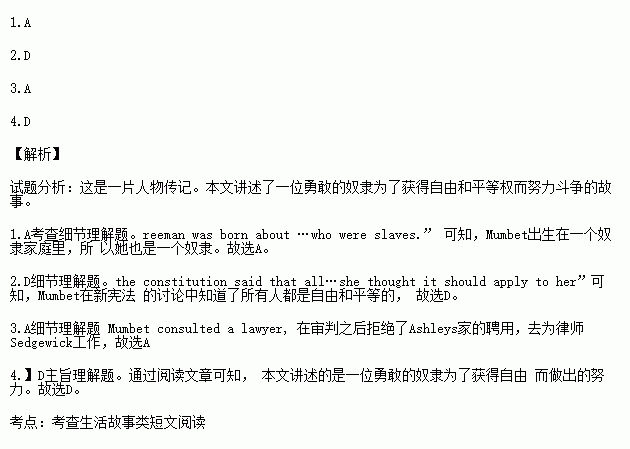题目内容
Elizabeth Freeman was born about 1742 to African American parents who were slaves. At the age of six months she was acquired, along with her sister, by John Ashley, a wealthy Massachusetts slaveholders. She became known as Mumbet or Mum Bett.
For nearly 30 years Mumbet served the Ashley family. One day, Ashleys wife tried to strike Mumbets sister with a spade. Mumbet protected her sister and took the blow instead. Furious(狂怒的), she left the house and refused to come back. When the Ashleys tried to make her return, Mumbet consulted a lawyer, Theodore Sedgewick. With his help, Mumbet sued(起诉) for her freedom.
While serving the Ashleys, Mumbet had listened to many discussions of the new Massachusetts constitution. If the constitution said that all people were free and equal, then she thought it should apply to her. Eventually, Mumbet won her freedom---- the first slave in Massachusetts to do so under the new constitution.
Strangely enough, after the trial, the Ashleys asked Mumbet to come back and work for them as a paid employee. She declined and instead went to work for Segdewick. Mumbet died in 1829, but her legacy lived on in her many descendants(后裔). One of her great-grandchildren was W.E.B. Du Bois, one of the founder of the NAACP, and an important writer and spokesperson for African American civil rights.
Mumbets tombstone still stands in the Massachusetts cemetery where she was buried. It reads, in part: She was born a slave and remained a slave and remained a slave for nearly thirty years. She could neither read nor write, yet in her own sphere she had no superior or equal.
1.What do we know about Mumbet according to Paragraph 1?
A.She was born a slave
B.She was a slaveholder
C.She had a famous sister
D.She was born into a rich family
2.What did Mumbet learn from discussions about the new consititution?
A.She should always obey her owners’ orders
B.How to apply for a job
C.How to be a good servant
D.She should be as free and equal as whites
3.What did Mumbet do after the trial?
A.She chose to work for a lawyer
B.She found the NAACP
C.She continued to serve the Ashleys
D.She went to live with her grandchildren
4.What is the test mainly about?
A.A story of a famous writer and spokesperson
B.The friendship between a lawyer and a slave
C.A trial that shocked the whole world
D.The life of a brave African American woman

